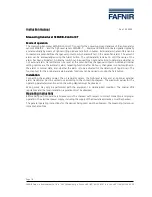
Honeywell
COMPONENT MAINTENANCE MANUAL
PART NUMBER 964-0452
I.B.1516A Page 37
Mar 30/01
23-12-01
2
Data Bus Controller, A8 —>Amplifier Control, A33
Module data bus information is stored with MS3 (X1 .4) = L and MWR (X1.5) =
L in latches D1-A and D4-A. Bit D0 (signal name TX) initiates the changeover of
the transmit/receive relay in Harmonic Filter, A32 (signal TRHF) and in Amplifier
Board, A31 (signal TRAMP) via gates D13-A, D7-B, and D7-E, D13-C.
The OPON and OPOFF signals are generated via gates, D14-A and D7-F.
These signals switch the operating point of the HF amplifier transistors.
With data bit D1 set, CROFF = H, and also deselects the operating points via
D7-D and D14-A, but without switching over the transmit/receive relay.
Signal PWINT also operates in the same way; in the event of a power failure, it
is set to L by Power Supply, A4, and deselects the operating points.
Data bits D8, D9, and 010 are passed as signals HF1, HF2, and HF3 to demul-
tiplexer, D16-A. This generates signals FILT1 to FILT7, which drive the relays
for filter range setting in Harmonic Filter, A32.
Data bits D11 and D12 are used as signals PI and P2 to generate the 2 30W
and 70W signals via D7-C and D13-B, which are used, as subsequently de-
scribed, to switch over the loop gain of the peak power control. These 2 signals
are also used to switch over voltage divider R210, R25, and R26 via transistors,
V24 and V25, and thus to switch over the SPRFP set power value with opera-
tional amplifier, N2-A, as a control input for regulating the HF power.
The voltage gain of N2-A can be continuously varied from V = 1 to V = 2 with
trimming resistor, R178, thus permitting exact adjustment of the output power in
Power Amplifier, A3.
Finally, the TRHF and TRAMP signals are suitched via gates, D12-C, D13-A,
D7-B, and D13-C with P1 = P2 = L in such a way that Amplifier Board, A31, is
not actuated during certain BIT tests despite TX being set.
With data bit D13 set, the signal TEST400W = H, and shorts the actual value of
average power control, N6-D, to ground via V38. This deselects the restriction
of the average power value to 125W in the XK516D1 HF Transceiver, in order
to obtain 400W
pep
for intermodulation measurement with 2 tones, for instance.
With data bit D14 set, signal DISCRG = H, which initiates rapid discharge of ca-
pacitors, C57, C59, via V37, R107, so that the ALC voltage is 0V at the begin-
ning of the next HF transmission, and the amplifier has maximum amplification.
Beyond that, capacitor, C131, of the average control, is discharged via transis-
tor, V57, and in addition, the power nominal value SPRFP is set to 100W
pep
via
V58 and R175.
With DISCRG = H, transistor, V34, is further disabled via R97. Consequently,
V35 becomes conductive via R99, and the DIODES signal is set to negative
voltage. This is necessary in order to discharge capacitors, C3 and C8, in phase
correction elements (N4-A and N4-C) of the ALC amplifier as well.
Data bit D15 switches the BITREL signal, which connects the HF power to a
47
Ω
resistor in Harmonic Filter, A32, as part of the BIT.
Page 59
















































